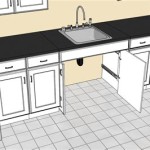Painting Light Oak Kitchen Cabinets: A Comprehensive Guide
Light oak kitchen cabinets, a staple in many homes for decades, often present a design challenge as styles evolve. Their warm, honeyed tones can sometimes feel dated compared to contemporary aesthetics. However, instead of a costly and disruptive kitchen remodel, painting light oak cabinets offers a cost-effective and transformative solution. This article provides a comprehensive guide to painting light oak kitchen cabinets, covering crucial preparation steps, paint selection, application techniques, and preventative measures to ensure a durable and professional finish.
The decision to paint light oak cabinets hinges on a few factors. The existing condition of the cabinets is paramount. If the cabinet boxes are structurally sound and the doors and drawers are in good working order, painting is a viable option. Consider the overall style of the kitchen. Is the goal to modernize the space or simply refresh its appearance? Painting allows for a change of color, contributing significantly to the overall atmosphere of the kitchen. Finally, assess the time commitment and skill level required. While painting cabinets is a DIY project, it demands patience, attention to detail, and a willingness to learn proper techniques.
Key Point 1: Meticulous Preparation: The Foundation for a Flawless Finish
Preparation is arguably the most critical aspect of painting light oak kitchen cabinets. It ensures proper paint adhesion, prevents imperfections, and ultimately contributes to the longevity of the finished product. Rushing or skipping steps in the preparation phase can lead to peeling, chipping, and an overall unprofessional appearance.
The first step is thorough cleaning. Years of cooking inevitably leave behind grease, grime, and food splatters on the cabinets. Use a degreasing cleaner specifically designed for kitchen surfaces. TSP (trisodium phosphate) or a TSP substitute are effective options. Follow the manufacturer's instructions carefully, wearing gloves and eye protection. Rinse the cabinets thoroughly with clean water to remove any residue from the cleaning product.
After cleaning, the next step involves removing all hardware, including knobs, pulls, hinges, and door bumpers. This allows for complete paint coverage and prevents paint from getting on the hardware. Store the hardware in labeled bags to ensure easy reinstallation later. If the hinges are in good condition, consider cleaning and reusing them. If they are worn or outdated, replacing them with new hardware can further enhance the updated look of the cabinets.
Sanding is an essential part of the preparation process for light oak cabinets. Oak is a porous wood with a prominent grain. Sanding helps to smooth the surface, creating a better bond for the primer and paint. Use a medium-grit sandpaper (around 120-grit) to lightly sand the entire surface of the cabinets. Pay particular attention to corners and edges. The goal is not to remove the existing finish entirely, but to scuff it up and create a "key" for the primer to adhere to. After sanding, use a fine-grit sandpaper (around 220-grit) to smooth out any rough spots. Thoroughly remove all sanding dust with a tack cloth or vacuum.
Filling any holes or imperfections is crucial for a smooth and professional finish. Use a wood filler to fill any nail holes, dents, or gouges in the cabinets. Apply the wood filler according to the manufacturer's instructions. Once the filler is dry, sand it smooth with fine-grit sandpaper. Again, remove all sanding dust before proceeding.
Masking off the surrounding areas is the final step in the preparation process. Use painter's tape to protect countertops, backsplashes, walls, and appliances from paint splatters. Cover the floor with drop cloths to prevent paint from dripping onto the flooring. Take the time to properly mask off these areas, as it will save time and effort in the cleanup process.
Key Point 2: Selecting the Right Primer and Paint: Ensuring Durability and Aesthetics
Choosing the correct primer and paint is crucial for achieving a durable and aesthetically pleasing finish on light oak kitchen cabinets. The primer serves as a bonding agent between the existing finish and the new paint, while the paint provides the desired color, sheen, and protection.
Primer selection is critical for oak cabinets due to their prominent grain. A high-quality stain-blocking primer is essential to prevent tannins in the oak from bleeding through the paint, which can cause discoloration. Oil-based primers are excellent at blocking stains but require mineral spirits for cleanup and emit strong odors. Water-based primers offer easier cleanup and lower VOCs (volatile organic compounds) but may require two coats to effectively block stains. Shellac-based primers are another option known for their excellent stain-blocking properties and fast drying time, but they are also more brittle and can be difficult to sand.
The choice of paint depends on the desired look and the level of durability required. Alkyd or oil-based paints offer a hard, durable finish that is resistant to scratches and chipping, making them suitable for high-traffic areas like kitchens. However, they require mineral spirits for cleanup and emit strong odors. Latex or water-based paints are easier to work with, offer lower VOCs, and clean up with soap and water. Acrylic latex paints provide better durability than standard latex paints and are a good choice for kitchen cabinets.
The sheen of the paint affects both the appearance and the cleanability of the cabinets. High-gloss paints are the most durable and easiest to clean but can highlight imperfections in the surface. Semi-gloss paints offer a good balance of durability and cleanability, while still providing a subtle sheen. Satin paints have a lower sheen than semi-gloss and are a popular choice for cabinets as they offer a smooth, elegant finish. Matte or flat paints have very little sheen and are less durable and more difficult to clean, making them less suitable for kitchen cabinets.
Consider using a paint specifically formulated for cabinets and trim. These paints are designed to provide a harder, more durable finish than standard wall paints. They are also often self-leveling, which helps to minimize brush strokes and create a smoother appearance.
Key Point 3: Application Techniques and Finishing Touches: Achieving a Professional Result
Proper application techniques are essential for achieving a professional-looking finish on painted light oak kitchen cabinets. The choice of tools and the method of application can significantly impact the final result.
For applying primer and paint, several options exist: brushes, rollers, and sprayers. Brushes are ideal for cutting in around edges and corners. Use a high-quality synthetic brush with angled bristles for best results. Rollers are suitable for painting large, flat surfaces. Use a foam roller or a roller with a short nap for a smooth finish. Sprayers provide the most even and consistent finish but require more preparation and skill to use effectively. An airless sprayer is a good option for painting cabinets, but proper ventilation and safety precautions are essential.
Apply the primer in thin, even coats, following the manufacturer's instructions. Allow the primer to dry completely before sanding lightly with fine-grit sandpaper. This will help to remove any imperfections and create a smooth surface for the paint to adhere to. Remove all sanding dust before proceeding.
Apply the paint in thin, even coats, allowing each coat to dry completely before applying the next. Multiple thin coats are better than one thick coat, as they are less likely to drip or sag. Sand lightly between coats with fine-grit sandpaper to remove any imperfections and create a smooth surface. Remove all sanding dust before applying the next coat.
Consider using a self-leveling paint additive to minimize brush strokes and roller marks. These additives help the paint to flow smoothly and create a more uniform finish. Follow the manufacturer's instructions carefully when using these additives.
Once the paint is completely dry, remove the painter's tape carefully. Score the edge of the tape with a utility knife before peeling it off to prevent the paint from chipping. Reinstall the hardware, taking care not to scratch the painted surface. Clean the hardware before reinstalling it to remove any dirt or grime. If necessary, adjust the door hinges to ensure that the doors hang properly and close smoothly.
Allow the painted cabinets to cure completely before using them. Curing time can vary depending on the type of paint used, but it typically takes at least a few days. Avoid placing heavy objects on the cabinets or exposing them to excessive moisture during the curing process.
After the paint has fully cured, inspect the cabinets for any imperfections or areas that need touch-up. Use a small brush to touch up any scratches, chips, or drips. Clean the painted cabinets regularly with a mild soap and water solution. Avoid using harsh chemicals or abrasive cleaners, as these can damage the paint finish.
By following these detailed steps and paying close attention to detail, it is possible to achieve a professional and durable finish when painting light oak kitchen cabinets. While the process requires time and effort, the transformation can significantly enhance the appearance of the kitchen and add value to the home.

Diy Painted Oak Kitchen Cabinets Makeover

Tips Tricks To Paint Honey Oak Kitchen Cabinets Cottage Living And Style

How To Update Oak Cabinets With Briwax Honey Stained Kitchen Updating
:strip_icc()/101671998-27cdf40f639448d0a56ff6c7eab609d7.jpg?strip=all)
Expert Tips For Painting Oak Cabinets

Paint Colors That Go With Oak Cabinets Julie Blanner

Great Ideas To Update Oak Kitchen Cabinets

Diy Painted Oak Kitchen Cabinets Makeover

Tips Tricks To Paint Honey Oak Kitchen Cabinets Cottage Living And Style

Paint Colors That Go With Oak Cabinets Julie Blanner

Should You Paint Oak Kitchen Cabinets White Tips And Tricks Jennifer Rizzo
Related Posts








